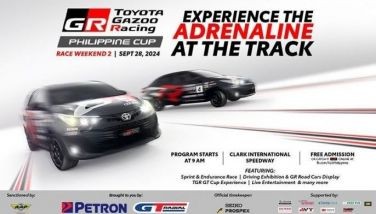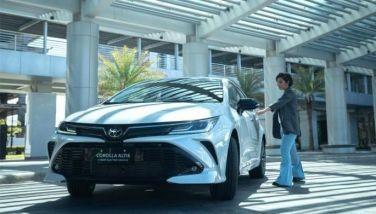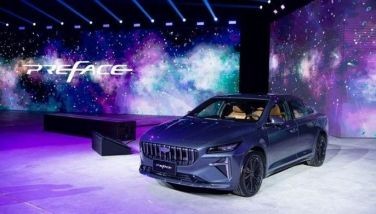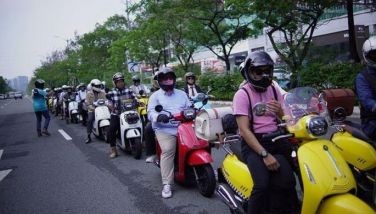2003 Yamaha Virago 535
October 15, 2003 | 12:00am
So, you’ve finally decided that motorcycling is for you. You reasoned that riding a motorbike is not only a healthy exercise, but it can save you travel time and fuel costs. Well, guess what? We think so, too.
To help you get into motorcycling, we decided to make a long-term evaluation of bike ownership, including the costs and the considerations involved. Manuel Gaspar "Boy" Albos, Jr., the SVP for marketing of Norkis Trading Corporation, the exclusive Philippine distributor of Yamaha motorcycles started us on our way by assigning this writer a brand-new 2003 Yamaha Virago 535.
The imported mid-sized cruiser is painted in "Urushi Black" (which is actually two-tone black and golden beige) and boasts of a 535cc four-stroke V-twin engine that makes 44.1bhp at 7500rpm and 34ft-lbs of torque at 6000rpm. With a wheelbase of 1520mm, a low seat height of 720mm and a claimed weight of 182kg, the Virago 535 is ideal for cruising in and out of the city. The bike may not fall under the "beginner bike" category (or even "everyday bike", for that matter) but it is light enough for a beginner and it could still prove adequate once your riding skills develop. Besides, it makes a great subject bike, so there.
I got the Virago 535 from the Mandaluyong office of Norkis with just 1.5 kilometers on the odometer. After signing all the necessary documents and checking the bike for overall delivered quality, tools and accessories like I bought it, I rode to the gas station, where it took in only 8.7 liters to top its 13.5-liter tank. I paid P173.35 for the top-up (try that in a car!) and recorded the odometer reading (3.4 km). I then rode around the city to get a feel of the bike and to evaluate its performance.
It is light and agile around town, the engine has got enough power to make life interesting, and it has enough ground clearance and handling competence to provide fun on a winding road. The seat height is low and those with short in-seams could plant their feet squarely on the ground. Seat and pillion are padded nicely to provide a comfortable ride and are contoured to follow the bike’s chopper-like stance. Controls are easy to reach and intuitive once you get to use them. A chromed pod houses the 180-kph speedometer while an aluminum box below it houses the idiot lights, which made me long for a tachometer. (Note to self: Peruse foreign bike magazines and scan internet for Virago accessories.)
When I got home, my wife helped me push the bike into my office where it will be stored when not in use. Parking it indoors made it unnecessary to buy a lock and chain to secure the bike at night as it also negated buying a lockable bike cover. However, we strongly recommend that you get these security accessories if you need to park your bike outdoors overnight. There are hooligans out there who’d like to get their hands on a bike without paying for it.
I made a spreadsheet logbook on my computer to monitor the expenses incurred on the bike. The records shall include registration and insurance, accessories/modifications, fuel costs, maintenance costs, fuel mileage and cost per kilometer and I shall include this every time I make a report. Should you like a copy of the spreadsheet so you could monitor your expenses on your bike, feel free to contact this writer through our motoring editor at The STAR or send me an email at [email protected].
Unfortunately, the weather, my globe-trotting schedule and my reluctance to use the spanking-new bike (not to mention other test rides and test drives of cars) conspired to keep me from riding the Virago 535 as often as I want. After four months of having the bike, I was only able to ride it for 345.4 kilometers. So far, I’ve managed to fill up the tank three times with a total fuel consumption of 22.2 liters costing P456.12. This translates to an average fuel mileage of 15.55 kilometers per liter and an average fuel cost per kilometer of P1.32. I’ve also had it washed once, paying P40.00 for the car, er, bike wash because I was too lazy to do it. Expenses like this fall under maintenance (not under "sloth") and are added to the total cost, which so far total P669.47, including the first tank full. Overall cost per kilometer is P1.94, which is cheaper than commuting on a PUV. Of course, this does not include the registration and insurance costs because I haven’t received these documents yet.
So far, so good. Our costs are low and the fun’s just starting. I’ll keep you posted on the progress of our long-term test ride Yamaha Virago 535 in our next report.
To help you get into motorcycling, we decided to make a long-term evaluation of bike ownership, including the costs and the considerations involved. Manuel Gaspar "Boy" Albos, Jr., the SVP for marketing of Norkis Trading Corporation, the exclusive Philippine distributor of Yamaha motorcycles started us on our way by assigning this writer a brand-new 2003 Yamaha Virago 535.
The imported mid-sized cruiser is painted in "Urushi Black" (which is actually two-tone black and golden beige) and boasts of a 535cc four-stroke V-twin engine that makes 44.1bhp at 7500rpm and 34ft-lbs of torque at 6000rpm. With a wheelbase of 1520mm, a low seat height of 720mm and a claimed weight of 182kg, the Virago 535 is ideal for cruising in and out of the city. The bike may not fall under the "beginner bike" category (or even "everyday bike", for that matter) but it is light enough for a beginner and it could still prove adequate once your riding skills develop. Besides, it makes a great subject bike, so there.
I got the Virago 535 from the Mandaluyong office of Norkis with just 1.5 kilometers on the odometer. After signing all the necessary documents and checking the bike for overall delivered quality, tools and accessories like I bought it, I rode to the gas station, where it took in only 8.7 liters to top its 13.5-liter tank. I paid P173.35 for the top-up (try that in a car!) and recorded the odometer reading (3.4 km). I then rode around the city to get a feel of the bike and to evaluate its performance.
It is light and agile around town, the engine has got enough power to make life interesting, and it has enough ground clearance and handling competence to provide fun on a winding road. The seat height is low and those with short in-seams could plant their feet squarely on the ground. Seat and pillion are padded nicely to provide a comfortable ride and are contoured to follow the bike’s chopper-like stance. Controls are easy to reach and intuitive once you get to use them. A chromed pod houses the 180-kph speedometer while an aluminum box below it houses the idiot lights, which made me long for a tachometer. (Note to self: Peruse foreign bike magazines and scan internet for Virago accessories.)
When I got home, my wife helped me push the bike into my office where it will be stored when not in use. Parking it indoors made it unnecessary to buy a lock and chain to secure the bike at night as it also negated buying a lockable bike cover. However, we strongly recommend that you get these security accessories if you need to park your bike outdoors overnight. There are hooligans out there who’d like to get their hands on a bike without paying for it.
I made a spreadsheet logbook on my computer to monitor the expenses incurred on the bike. The records shall include registration and insurance, accessories/modifications, fuel costs, maintenance costs, fuel mileage and cost per kilometer and I shall include this every time I make a report. Should you like a copy of the spreadsheet so you could monitor your expenses on your bike, feel free to contact this writer through our motoring editor at The STAR or send me an email at [email protected].
Unfortunately, the weather, my globe-trotting schedule and my reluctance to use the spanking-new bike (not to mention other test rides and test drives of cars) conspired to keep me from riding the Virago 535 as often as I want. After four months of having the bike, I was only able to ride it for 345.4 kilometers. So far, I’ve managed to fill up the tank three times with a total fuel consumption of 22.2 liters costing P456.12. This translates to an average fuel mileage of 15.55 kilometers per liter and an average fuel cost per kilometer of P1.32. I’ve also had it washed once, paying P40.00 for the car, er, bike wash because I was too lazy to do it. Expenses like this fall under maintenance (not under "sloth") and are added to the total cost, which so far total P669.47, including the first tank full. Overall cost per kilometer is P1.94, which is cheaper than commuting on a PUV. Of course, this does not include the registration and insurance costs because I haven’t received these documents yet.
So far, so good. Our costs are low and the fun’s just starting. I’ll keep you posted on the progress of our long-term test ride Yamaha Virago 535 in our next report.
BrandSpace Articles
<
>
- Latest
Latest
Latest
September 30, 2024 - 4:26pm
By EC Toledo | September 30, 2024 - 4:26pm
September 26, 2024 - 3:30pm
September 26, 2024 - 3:30pm
August 16, 2024 - 11:00am
By Euden Valdez | August 16, 2024 - 11:00am
Recommended





























